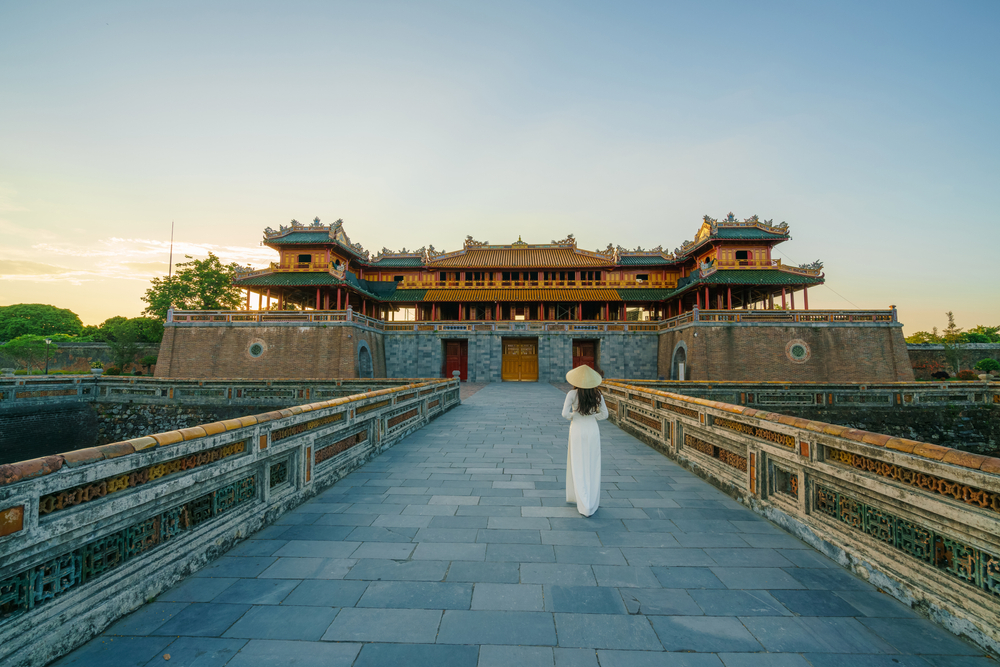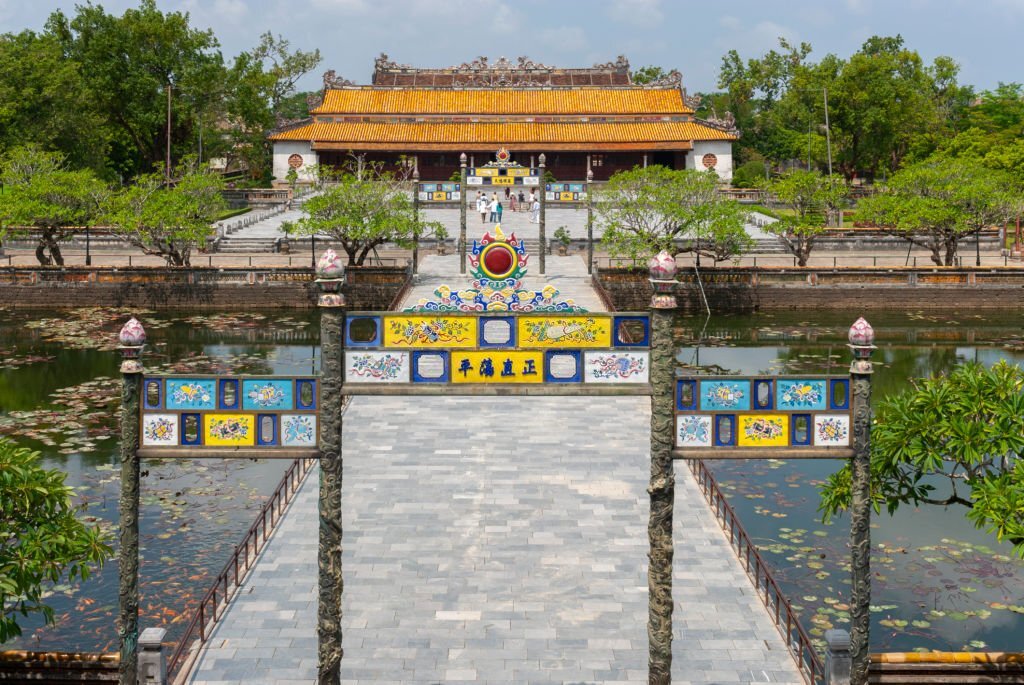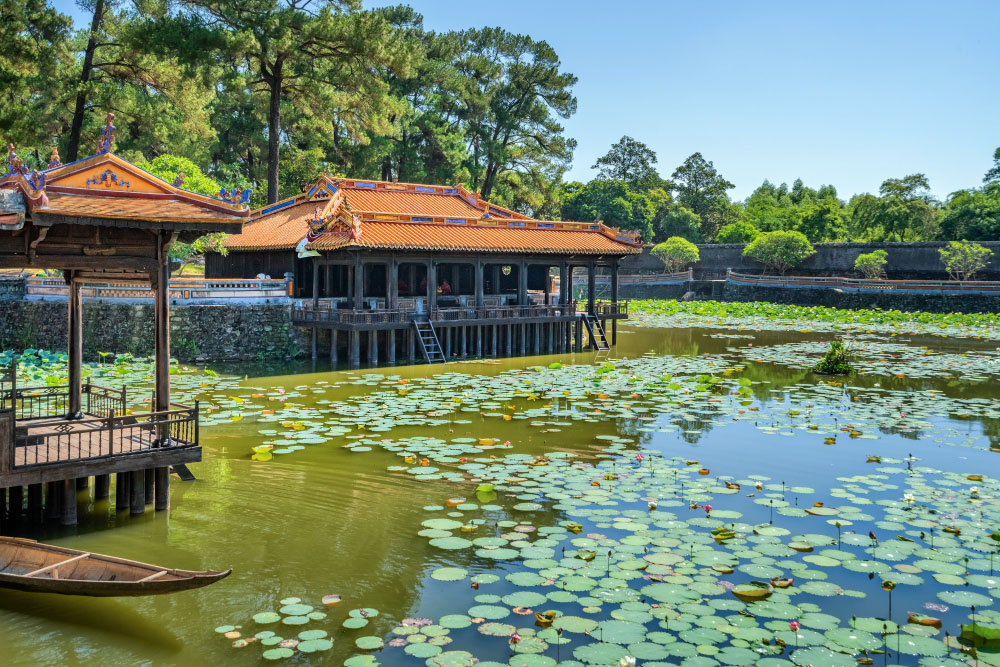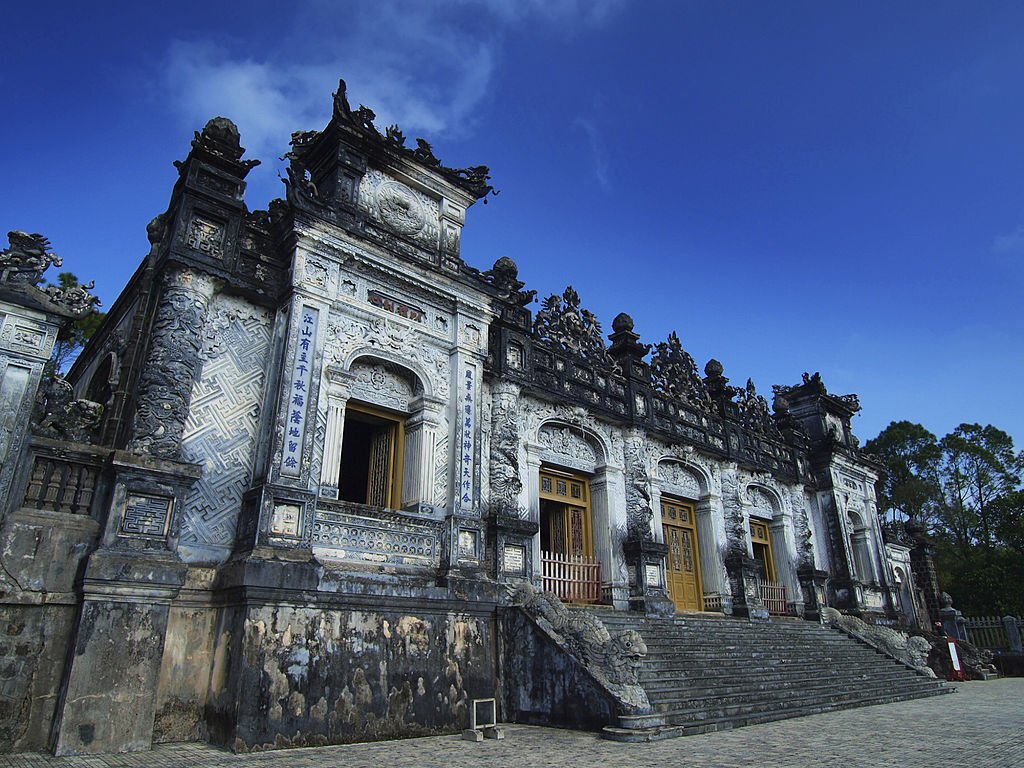The streets in the city center are modern, with some sumptuous buildings with prestigious hotels and plenty of shops and restaurants. The center does not offer much to see, apart from the riverfront area with souvenir shops and restaurants, but it is a pleasant and peaceful place for walking and eating after visiting the Citadel and the Imperial Tombs. It should also be remembered that thanks to the imperial past, Hue boasts one of the richest and most varied cuisines in Vietnam, with many typical dishes that can only be tasted here. It is interesting that your stay in Hue also becomes a gastronomic tour to enjoy delicious Vietnamese flavors.
Guarded inside the imperial enclosure erected by the French based on the canons of European military architecture, the complex of the Imperial Citadel is one of the most precious architectural treasures of Vietnam, although many temples are in bad condition and some remain only ruins. Nevertheless, it is undeniable that the buildings here can create great impressions, starting from the mighty walls of over 6 meters high. Inside there is a complex of palaces, temples, pavilions, gardens, and ponds that together make up the Citadel.
Being the capital of Vietnam since the beginning of the Nguyen dynasty in 1802 until the abdication of the last emperor, Bao Dai, in 1945, the Imperial City is very reminiscent of Chinese architecture and the great Forbidden City in Beijing. In fact, wandering through the avenues and admiring the pavilions will create the distinct feeling of traveling back to the Last Emperor! It is unfortunate that in 1947, a devastating fire damaged many structures but luckily the most beautiful was saved and after careful restoration, they returned to their former glory.
Inside the Citadel is the real Imperial City, a city protected by walls and ditches that traces the plan of the Forbidden City in Beijing. Inside there are restored pavilions lined internally with vermilion red lacquers with a decoration widely present in Chinese architecture, and gorgeous temples. Even the ancient gates accessing to the Imperial City have been color-faded, it still retains an aura of charm.

Among these, the most interesting buildings to see are:
The monumental Moon Gate (or Ngo Mon), which is today’s main access to the Citadel. Inside there is a huge drum that imprintes the Tao, symbol of the flow of life and the evolution of everything.
The Supreme Harmony Palace (Thai Hoa Palace): once being the hall of the emperor’s government, it has a vermilion-red lacquered wooden column with decorations in gold and the original throne is placed in a raised position to testify to the emperor’s power. The courtyard in front, called the Esplanade of the Great Greetings, was the place where the mandarins stood during the imperial ceremonies.
In Tu Phuong Pavilion, immersed in a lush garden is the Imperial Library built in 1820, facing a small pool with a small island in the middle.
Hien Lam Pavilion with red vermilion and gold lactate doors is one of the best-preserved buildings. The courtyard in front of the pavilion presents the 9 urns dedicated to each of the emperors of the Nguyen dynasty, which symbolize their stability and power. The urns, over 2 meters high, were made in 1830 and then chiseled with traditional Chinese motifs representing natural elements.
In the Forbidden City where the emperor’s wives and concubines lived, there are only a few traces remaining and the perimeter wall (damaged and faded quite a lot) that reminds about its initial time.

Each emperor had his own tomb built to remind posteriors about his existence. These grandiose complexes are scattered in the countryside along the Perfume River banks and in the vicinity of Hue. The best way to visit the tomb is to take part in a half-day boat trip along the river, with stops at the main graves. You can opt for a private car tour, which you can purchase directly at the hotel, especially in the summer since a boat tour is not really an ideal choice in the high temperatures.
Tu Duc Tomb is the most famous one with the greatest tourist influx. This complex is perfectly integrated with the surrounding environment, with palaces and temples scattered in an area of 12 hectares between pine and frangipani woods. Built between 1864 and 1867, the complex was used by the emperor when he was alive as a place of leisure and summer residence to which he could directly access via the river. Many of the original buildings have been destroyed during the war but some buildings of great interest can still be admired. The main one is the Stele Pavilion. It is so called because it preserves the stele engraved with the biography of Tu Duc written by the emperor himself.

On the other hand, Khai Dinh Tomb shows the evolution of Vietnamese architecture under French influence. No more wood and lacquers but only stone. The tomb, dating back to 1925, is located in a position away from the river, in the countryside around Hue, and can, therefore, be reached by taxi. The complex is nowadays much blackened and would require restoration, but it is interesting from a historical point of view because it bears witness to the French influence in the Vietnamese government, which is so powerful as to modify its architectural traditions. The tomb of the emperor housed in the main building is a riot of gold and gems, a bit tacky but definitely impressive. Very striking are the stone mandarins that occupy the central courtyard and have the symbolic function of protecting the tomb.

Beside the main tombs, you can also visit Thien Mu Pagoda, which is located on a hill right at the river. At the entrance, there is a large octagonal tower built in 1845 with seven floors that indicate the reincarnations of the Buddha. It is a beautiful view of the river from the courtyard where the tower stands. Within the complex, there are numerous temples and pavilions, but not all of them allow visitors to enter.
